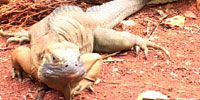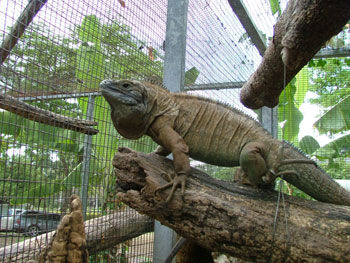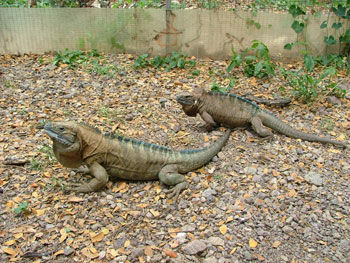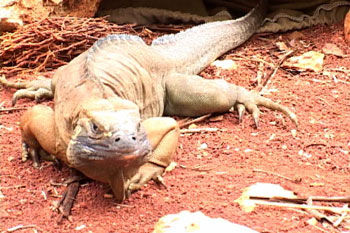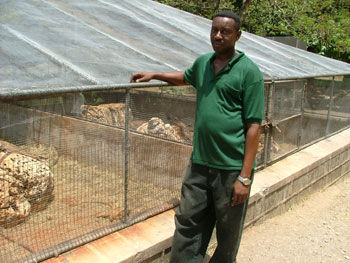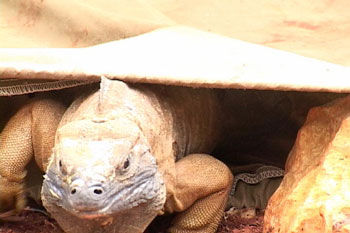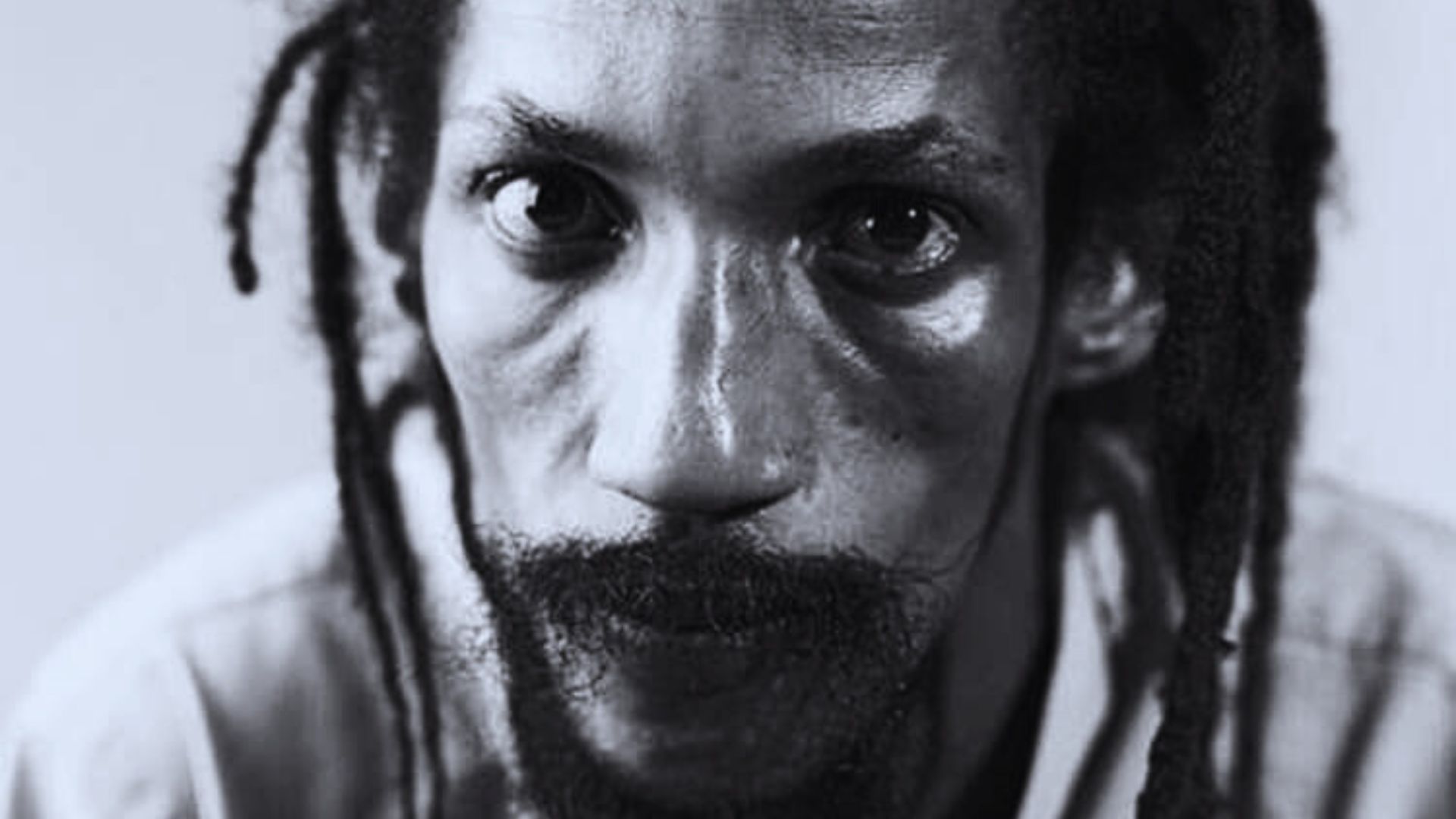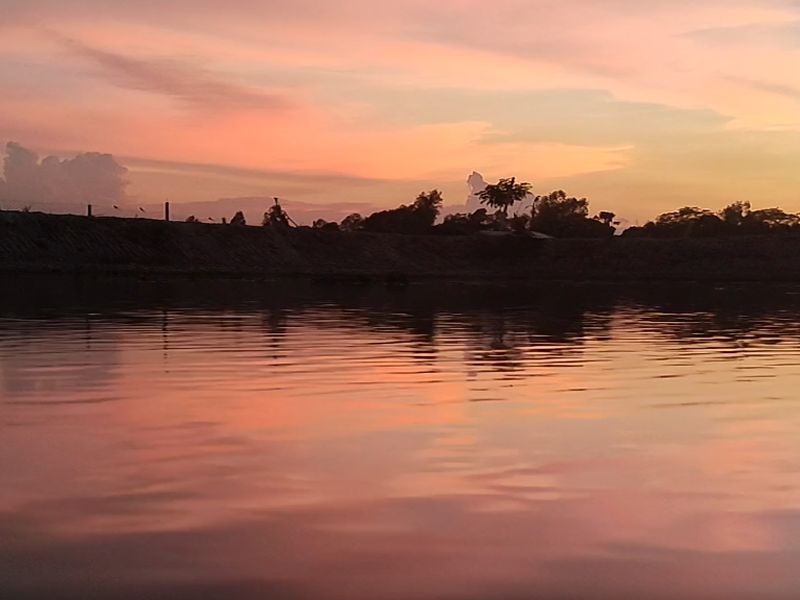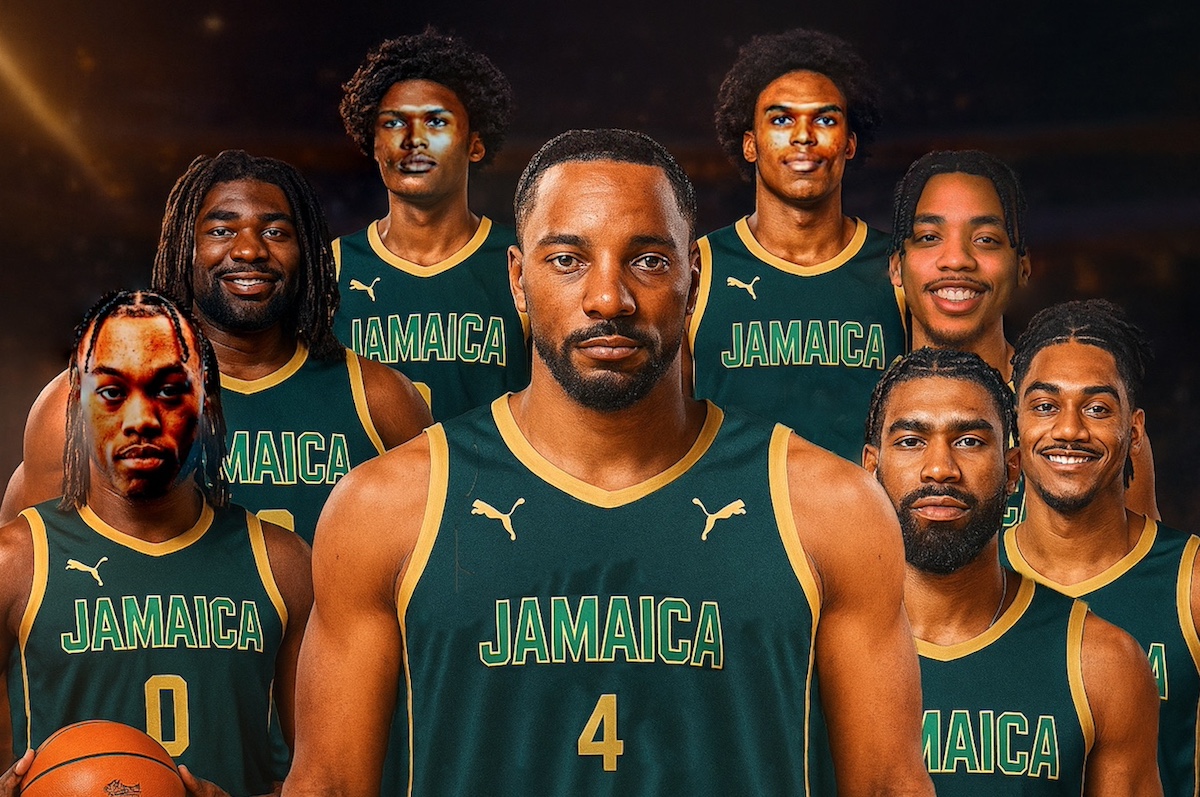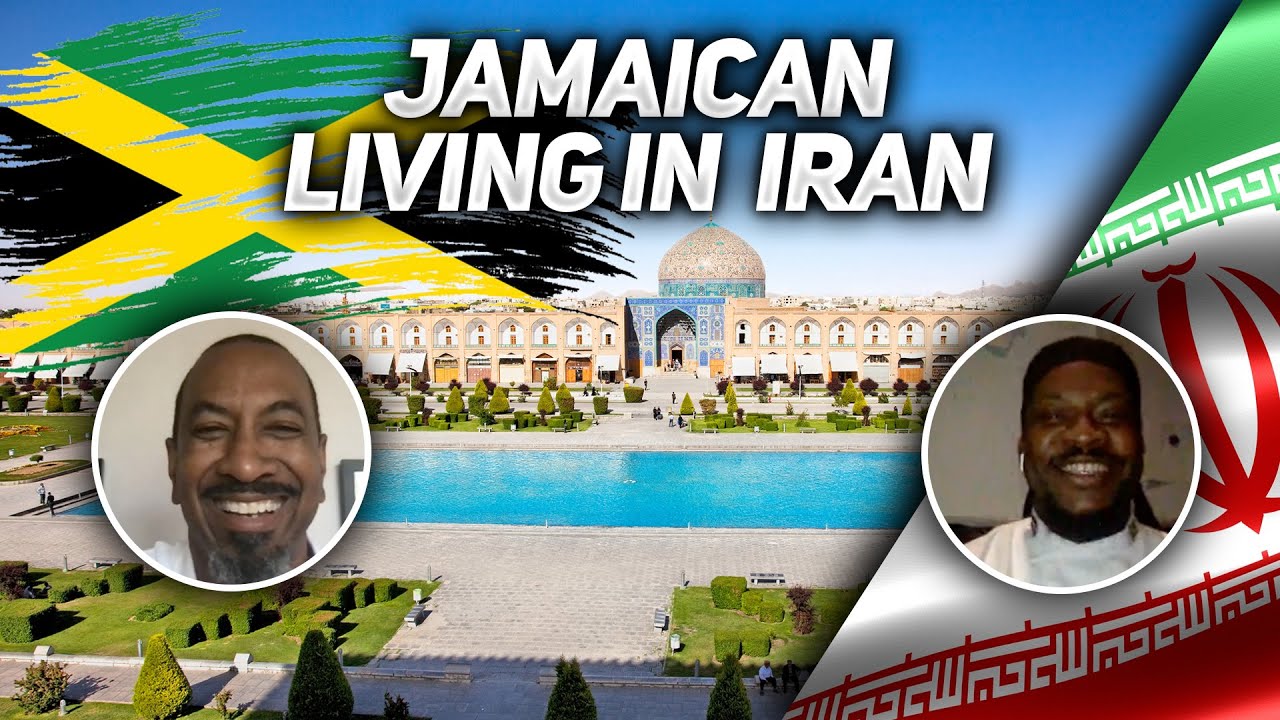Famed for being the birthplace of reggae, for its glorious white sandy beaches and the warmth of its people, Jamaica’s wildlife are often overlooked and not just by tourists. Jamaicans are not especially known for being animal lovers. For example, most of the island’s dogs are kept not as pets and companions but as guards, alerting their owners to strangers and intruders, having little interaction with their keepers. It is not unusual to observe on a daily basis, several carcasses strewn across the highways and busy roads, almost symbolising the nation’s apparent lack of interest in its animal kingdom. This is a pity, given the number of rare species, which occur naturally in Jamaica and are hence, endemic.
One such remarkable specimen that in recent years has attracted concern and interest both from within and outside Jamaica is the Jamaican Iguana. Measuring up to 150cm as an adult, it is the island’s largest native land animal. It’s tenacity and resilience is surely characteristic of the Jamaican people – at one point it was thought to be extinct. The male Iguanas are dominant beasts that are fiercely protective of their territory – not unlike their human counterparts! In my opinion it is the King of the reptile world.
The Jamaican Iguana (cyclura collei) is on the world endangered species list as the adult population is thought to be below 200. It was once thought to have been common in Jamaica around the seventeenth century, around drier parts of the south coast. However, its numbers declined dramatically in the latter part of the nineteenth century, following the introduction of the Indian mongoose, which kills and eats juveniles and their eggs. By 1948 the Jamaican Iguana was considered extinct.
In 1970 a wild pig hunter stumbled across an Iguana carcass in the Hellshire Hills. That was the first sighting in almost thirty years. In 1990 another hunter and his dog found a live specimen which was brought to Hope Zoo. Following this discovery the Jamaican Iguana Research and Conservation Group (JIRCG) was formed, bringing together representatives from Hope Zoo, University of the West Indies, Natural Resources Conservation Authority and the Institute of Jamaica. They carried out an intensive survey of the Hellshire Hills to determine the number of surviving Iguanas. It was a massive campaign supported by a large number of volunteers, who spent nearly 7500 man-hours combing the rugged limestone terrain.
They discovered that there were at least fifteen Iguanas remaining in the central and western sections of the Hellshire Hills and two active nesting sites. They were no longer present elsewhere, as a result of charcoal burning by locals which had destroyed a large part of their natural habitat in the north-eastern section. In addition they found that other threats posed were from ferals, namely cats, dogs and pigs.
Several strategies have since been adopted to ensure the survival of the Jamaican Iguana, which after all forms part of the island’s history and which is an integral part of its heritage. I am suggesting that a model of the Jamaican Iguana be erected in National Heroes Park as a symbol of its fight for survival, like our enslaved ancestors who fought for and eventually won our freedom.
Six participating zoos from within the USA (Fort Worth, Indianapolis, Central Florida, Sedgewick Country, Gladys Porter and San Diego (home of the Centre for the Reproduction of Endangered Species) are establishing a satellite population.
A consortium of twelve zoos, also from within the USA donated and constructed a Headstart Facility at Hope Zoo, used for the rearing of eggs and hatchlings brought from the wild. From within the safety of this captive environment, they are reared until at between three and four years old, they are large enough to survive in the wild and predators such as the mongoose are no longer a threat. The Headstart facility also carries out health screening prior to the release of specimens.
The JIRCG has also engaged in predator control programmes, mostly involving volunteers, which capture mainly mongoose through the use of traps. There are two campsites within the Hellshire Hills where volunteers remain for several weeks at a time following the release of young adults from the Headstart programme.
Field research is carried out, with efforts largely due to both foreign and local masters students who have looked at behavioural patterns, nesting ecology and assessment of the viability of their habitat. In addition all animals released are tagged electronically or with beads and data is collected periodically on their growth and development. Since the Headstart programme commenced in 1996 around 45 Jamaican Iguanas have been released into the wild.
The JIRCG recently received funding to the tune of U$10,000 from the International Iguana Foundation. Orlando Robinson, curator at Hope Zoo advised that the money will be used to improve breeding facilities, providing better conditions around the captive breeding areas. Additionally, it will provide incubators and stand-by generators where the eggs are stored.
One of the Jamaican Iguanas’ primary carers at Hope Zoo is Ordel Williams. He has worked at the Zoo for twenty years. Looking back, he recalls that at the time of his arrival in the 80’s, the Jamaican Iguana was believed to be extinct and he had never seen one of the reptiles before. His first encounter was in 1991 after they had been rediscovered and brought to Hope Zoo.
His responsibilities under the Headstart programme are to ensure that the Iguanas are fed, that their cages are kept clean and that there is adequate perching and material for nesting. As part of the monitoring process he has to weigh the Iguanas periodically which he admitted is no mean feat as it can be quite a job even to catch them! During our interview he told me that “they sometimes run you down” and can be very aggressive, being terrestrial animals.
Ordel received specialist training at Fort Worth Zoo where in addition to general care and maintenance he also learnt how to sex the younger Iguanas. It is easier to distinguish between adult males and females as the males are much larger with buccal enlargements (looks like an oversized and elongated Adam’s apple)!
At the time of our interview (April 2004) Ordel was busy preparing for the June breeding programme, which involved landscaping and preparing the nesting and holding areas. He told me that he feels privileged to have the responsibility of looking after one of Jamaica’s most robust reptiles and thinks that their fight for survival is truly amazing.
“ Hellshire Hills is the most important area to Jamaica in terms of biodiversity”. So explains Peter Espeut, Executive Director of CCAM (Caribbean Coastal Areas Management Foundation). During a recent interview (April 2004) he advised me that in addition to the Jamaican Iguana, the Hellshire Hills is also home to four other endemic reptiles. Located to the west of Kingston it is a rugged, dry limestone forest measuring approximately ten by fifteen kilometres.
The four other endemic reptiles found there are the Jamaican Boa, Thunder snake, blue tailed galliwasp and the skink. There is no where else in the world where these can be found in the wild.
The area in Hellshire Hills in which they are to be found is known as the Portland Bight Protected Area which is protected under Jamaican Law.
In addition to endemic reptiles there are also thirteen endemic species of birds, and marine life, being the primary nesting site for turtles and sea birds. The salt island lagoon near to Hellshire Hills is a habitat for ducks, which fly in from the north. You will find Jamaica’s only fish-eating bat (Noctilio leporinus) along with a whole host of other rare and interesting creatures. Nineteen per cent of the trees found at Hellshire are endemic. There are also 271 species of plants of which 53 are endemic.
Peter Espeut believes that the key to ensuring the preservation of this area is enforcement of the Wildlife Protection Act, which falls under the responsibility of the National Resources Conservation Authority. However to date enforcement of the act and day to day management of the area has been non-existent. Therefore the Jamaican Iguana is still in critical danger from the influx of exotics (the mongoose, cats, dogs and wild pigs) and by the continued use of charcoal burning eradicating their natural habitat. Worse still there is a very real threat from development with the UDC (Urban Development Corporation) proposing that part of the site be used for housing. Such a project involving large-scale limestone mining would prove disastrous for the Jamaican Iguana. Not least because the roads that would need to be built to enable mining would provide a gateway for the charcoal burners and pig hunters along with their dogs to move further into the forest.
CCAM, in collaboration with Dr. Peter Vogel (JIRCG) drew up a comprehensive management plan for the Portland Bight Protected Area, which was submitted to the NRCA in 1999. Funds were applied for and have been raised according to Peter Espeut to enable its implementation. The plan would see the Hellshire Hills being zoned into three areas with the erection of ranger stations to the east and north of the site. Regular patrols would ensure that vulnerable areas such as nesting sites would be restricted only to conservation workers. Working alongside the JIRCG Peter Espeut states that CCAM would “continue and expand existing programmes such as the trapping and removal of predators”. He also stated that CCAM would work alongside the community “increasing the pool of educationally aware citizens”.
It is unclear why after five years that the plan has yet to be implemented. Both CCAM and representatives from the JIRCG point to politics and bureaucracy as the cause of the unprecedented delays. With all the valiant efforts that have thus far been made to ensure the survival of the Jamaican Iguana, it is sincerely hoped that the situation is rectified in the very near future. Jamaica cannot afford to lose its King of Reptiles.
Acknowledgements: Orlando Robinson Curator, Hope Zoo; Dr. Peter Vogel UWI, JIRCG; Peter Espeut Executive Director, CCAM
